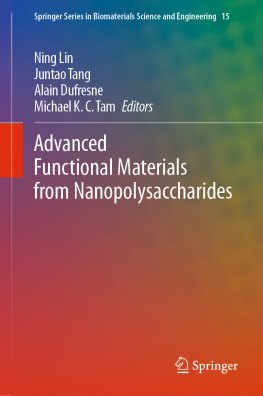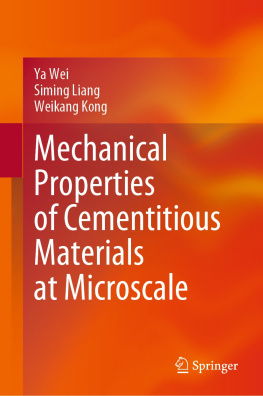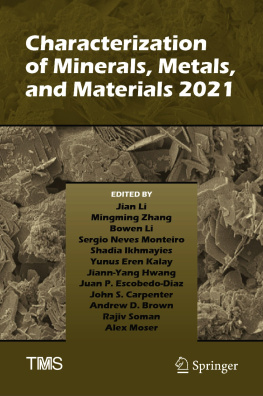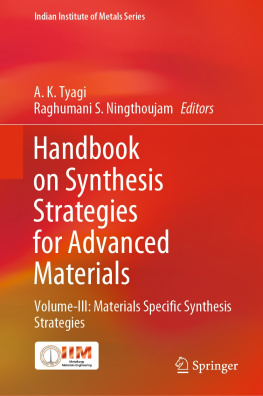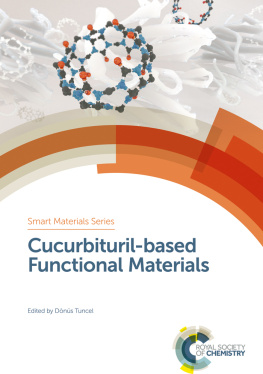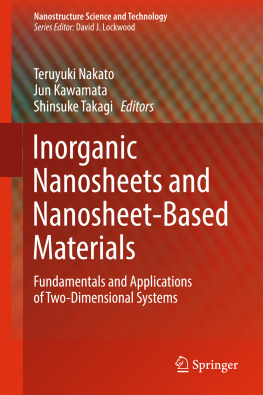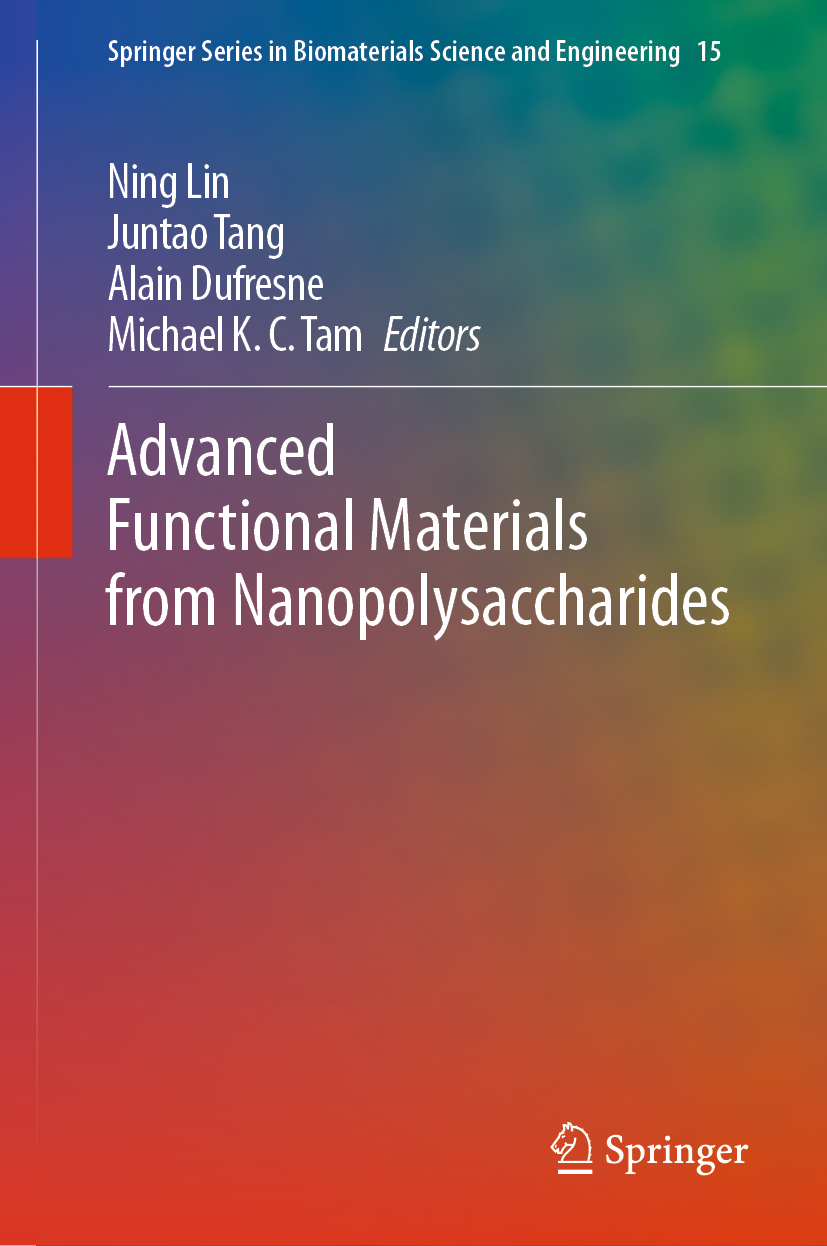Volume 15
Springer Series in Biomaterials Science and Engineering
Series Editor
Min Wang
Department of Mechanical Engineering, The University of Hong Kong, Pokfulam Road, Hong Kong
Aims and Scope
The Springer Series in Biomaterials Science and Engineering addresses the manufacture, structure and properties, and applications of materials that are in contact with biological systems, temporarily or permanently. It deals with many aspects of modern biomaterials, from basic science to clinical applications, as well as host responses. It covers the whole spectrum of biomaterialspolymers, metals, glasses and ceramics, and composites/hybridsand includes both biological materials (collagen, polysaccharides, biological apatites, etc.) and synthetic materials. The materials can be in different forms: single crystals, polycrystalline materials, particles, fibers/wires, coatings, non-porous materials, porous scaffolds, etc. New and developing areas of biomaterials, such as nano-biomaterials and diagnostic and therapeutic nanodevices, are also focuses in this series. Advanced analytical techniques that are applicable in R&D and theoretical methods and analyses for biomaterials are also important topics. Frontiers in nanomedicine, regenerative medicine and other rapidly advancing areas calling for great explorations are highly relevant.
The Springer Series in Biomaterials Science and Engineering aims to provide critical reviews of important subjects in the field, publish new discoveries and significant progresses that have been made in both biomaterials development and the advancement of principles, theories and designs, and report cutting-edge research and relevant technologies. The individual volumes in the series are thematic. The goal of each volume is to give readers a comprehensive overview of an area where new knowledge has been gained and insights made. Significant topics in the area are dealt with in good depth and future directions are predicted on the basis of current developments. As a collection, the series provides authoritative works to a wide audience in academia, the research community, and industry.
More information about this series at http://www.springer.com/series/10955
Editors
Ning Lin , Juntao Tang , Alain Dufresne and Michael K. C. Tam
Advanced Functional Materials from Nanopolysaccharides
Editors
Ning Lin
School of Chemistry, Chemical Engineering and Life Sciences, Wuhan University of Technology, Wuhan, Hubei, China
Juntao Tang
College of Chemistry and Chemical Engineering, Central South University, Changsha, Hunan, China
Alain Dufresne
Grenoble INP, Grenoble, France
Michael K. C. Tam
Department of Chemical Engineering, University of Waterloo, Waterloo, ON, Canada
ISSN 2195-0644 e-ISSN 2195-0652
Springer Series in Biomaterials Science and Engineering
ISBN 978-981-15-0912-4 e-ISBN 978-981-15-0913-1
https://doi.org/10.1007/978-981-15-0913-1
Springer Nature Singapore Pte Ltd. 2019
This work is subject to copyright. All rights are reserved by the Publisher, whether the whole or part of the material is concerned, specifically the rights of translation, reprinting, reuse of illustrations, recitation, broadcasting, reproduction on microfilms or in any other physical way, and transmission or information storage and retrieval, electronic adaptation, computer software, or by similar or dissimilar methodology now known or hereafter developed.
The use of general descriptive names, registered names, trademarks, service marks, etc. in this publication does not imply, even in the absence of a specific statement, that such names are exempt from the relevant protective laws and regulations and therefore free for general use.
The publisher, the authors and the editors are safe to assume that the advice and information in this book are believed to be true and accurate at the date of publication. Neither the publisher nor the authors or the editors give a warranty, expressed or implied, with respect to the material contained herein or for any errors or omissions that may have been made. The publisher remains neutral with regard to jurisdictional claims in published maps and institutional affiliations.
This Springer imprint is published by the registered company Springer Nature Singapore Pte Ltd.
The registered company address is: 152 Beach Road, #21-01/04 Gateway East, Singapore 189721, Singapore
Preface
Polysaccharide is a type of carbohydrate molecules composed of long polymeric chains with monosaccharide units as building blocks covalently bound together by glycosidic linkages. The typical polysaccharides in nature are cellulose, chitin, and starch, which commonly exist in the plants, animals, microorganisms, and bacteria. Derived from the strong intra- and inter-molecular hydrogen bonds, the crystalline and amorphous regions by the ordered arrangement and assembly of the linear and highly branched polymeric chains constitute the microstructures of these polysaccharides. Nanopolysaccharides can be produced by the partial or complete removal of amorphous regions, which is a kind of novel materials with the preservation of crystalline region and possesses the nanometer scale (<100 nm) at least one dimension. The typical nanopolysaccharides include the highly crystalline cellulose nanocrystal, chitin nanocrystal, and starch nanocrystal, together with the semi-flexible cellulose nanofibril and chitin nanofibril. As the nanoscaled aggregates of natural polymers, these nanopolysaccharides exhibit numerous advantages in comparison with conventional inorganic and metal nanoparticles, for instance, renewability, low toxicity, biodegradability, biocompatibility, high mechanical modulus but low density, high specific area and surface activity, morphological regulation, etc. Since the first report by Dr. Alain Dufresne on the use of cellulose nanocrystal as the rigid filler to enhance the mechanical property of rubber-based composite, the application of nanopolysaccharides in materials science has attracted a surging number of researchers in this field. With the continuous attempt during last thirty years, the functional materials based on nanopolysaccharides were rapidly developed, involving the exploration of their novel properties and additional added values in diverse applications taking the special functions but not only mechanical enhancement. Focusing on the nanocellulose, nanochitin, and nanostarch, this monograph is the summarization and discussion on the functional materials from these three nanopolysaccharides covering the studies in recent ten years on this topic.
The structural framework of this monograph is organized according to the specific functional applications of nanopolysaccharides with 12 chapters. In each chapter, the strategy of constructing the functional system and the critical concerns of the functional materials (for instance, the functional mechanism) are summarized and commented on the basis of the reported studies, which are expected to be an inspiration or reference to the readers for their work. The potential functions and applications of a nanomaterial firstly depend on its intrinsic properties, and therefore, Chap.offers an overview of Pickering emulsions stabilized by pristine and modified nanopolysaccharides on the definition, instability mechanism, and potential applications.

